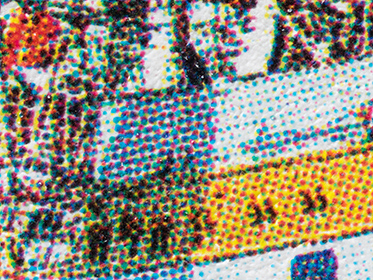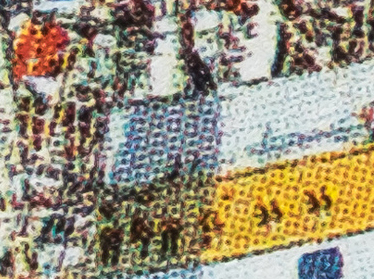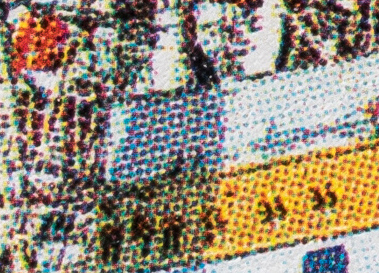30/09/16 10:43
In the 1920s the Leitz company had a wide product portfolio, consisting of all kinds of optical systems (lenses) microscopes, binoculars, cameras and a broad assortment of scientific-optical measurement instruments. All of these products were designed and manufactured in Wetzlar. More than 5000 (the peak was 7000) workers were involved in the production of these instruments. A camera was also considered an instrument.
After the war the scientific instruments were slowly phased out and the company profiled itself with the microscopes and the cameras, still and movie, and the lenses. The portfolio was quite broad but focused on photography, cinematography and viewing. Projectors and even darkroom equipment were included. At the end of the 20th century the microscope and optical-scientific division was integrated in a separate company and the camera division was on its own with a much reduced portfolio, consisting of the iconic M-system, the ailing R-system, a lacklustre range of compact cameras, made by Japanese companies and a sprinkling of digital cameras, also made by Japanese companies.
Now located in the Wetzlar Park, the Leica company is again on an expansionist tour. A wide range of digital cameras, the compact ones from Panasonic and many of the high-end cameras clearly inspired by equivalent Sony products, has been supplemented by a range of cinematographic lenses, (even a new Leicina is being suggested), a Fuji-made Instant camera and Huawei smart phones. The Wetzlar Park gets a movie theatre, a hotel and a Max Berek lab for artificial intelligence and more of this type of research. The lab personnel is partly from the research centres of Huawei in Europe and China.
The new lenses for the T and SL camera systems are, to say the least, inspired by Panasonic designs and the performance goal is inspired by the Zeiss lens range. Zeiss has increased the 40 lp/mm goal from the classical 40 - 50% at a new level (70%) and this is also the target for the new Leica lenses for the digital cameras. The S-lenses were the first with this new level of performance, but had moderate apertures.
The good point of these new targets is the increased level of detail that is possible with potential new sensors of smaller pixel pitch and higher amount of pixels per square mm.
The bad point is the narrow focus depth and related circle of confusion. At wider apertures these lenses show a steep sharpness gradient and a very narrow sharpness plane. Very accurate focusing is required to exploit the feature of heightened sharpness and contrast. Zeiss has the easier task because the focusing is manual and the operator therefore responsible for the result. Leica has opted for autofocus and this requires a fast and accurate AF mechanism. This is not easy to design and manufacture and may explain the slow introduction of the lenses on the SL-roadmap.
The new levels of performance and the trend to 40 Mp sensors in small-format cameras may be fine for the marketing department and for photographers who are conscious of the prestige of this trend. The big question however is how the quality of the images will and can be increased. Handheld photography with the new large and heavy lenses (see the new 1.4/50 mm lens for the SL) is difficult and vibration reduction may be required to exploit the new options. There is however the possibility that the technique sets the limits and defines the content of the pictures. The street photographers have produced a large amount of identical pictures showing blind beggars, barber shop porches and empty or populated benches in parks, or sleepy persons in subways.
29/09/16 22:19
Several visitors of the site have inquired why I do not review the new products that are being announced by Leica. The simple fact is that I am not asked to test these products. The reason why is a mystery to me.
29/09/16 21:33
Most reviewers/testers on most websites claim that the bigger the sensor the better will be the results. This is the conventional wisdom. I received a few images from Dr. Nasse (regrettable no longer with us) who argued that this wisdom is not supported by scientific testing. The first image is an enlarged picture of the original image: part of a a post stamp. The next two images are from a MicroFT and a APS-C camera. There is no difference in visual appearance. Of course, there are many other characteristics to discuss, but when the the main criterion (image sharpness) is selected, the images are proof that there is no difference at all.



The upshot?
The effectiveness of the software nowadays provides the camera manufacturers with enough options to compensate for the differences in format and pixel pitch.
29/09/16 21:17
There were problems with the printing and I am informed now that the delivery date will be now end of October. The books will ship early November. I apologise for the delay!
12/09/16 19:06
The printer informed me today that the book will be ready end of September. So I will start shipments in the first week of October.
12/09/16 16:33
One of the least acknowledged ‘truths’ in the world of photography is a rule from perception theory: “you see what you know and not you know what you see”. It is the difference between interpretation and observation. It has particular relevance for the theory of photography. A photograph has no meaning: it is a frame, a window on physical reality, devoid from context and from the flow of time. It does not tell a story and it does not reveal what is behind the surface of the physical objects that are depicted. This was the discovery of the nineteenth century when a photograph was compared to a painting or drawing. A painting was full of references, carefully drafted and included in the main tableau by the painter. A photograph was the result of a mechanical instrument and could only reproduce what was before the lens. This was most unsatisfactory and during the twentieth century photographers claimed that style was the substance of a photograph. Not the physical object was the target, but the way it was photographed: standpoint, viewing angle, choice of lens and time and more selectable aspects made the photograph to a meaningful picture, because the intention and goals of the photograph became visible. The picture says more about the maker than about the subject. This is the artistic attitude and many pages are indeed written about the maker’s intentions. This however is an invention by gallery owners and art historians.
The twenty-first century changed all that again. The digital technology engulfed photography and the photograph became artificial, a construct of pixels that could be manipulated individually. The protagonists of digital constructions defend the act of photoshopping a person into the shape of the standard beauty ideal by referring to the fact that retouch is and was a standard practice to create the Playboy next door girl.
It is true that digital technology can create photographs of the old, analog type and it is the Leica community in particular that claims that digital (Leica) photography is identical to analog (Leica) photography, only with different technological means. The whole concept of a special type of photography, identified as Leica photography, is a bit suspect. Who can claim that he is able to identify a photograph made with a Leica from a bunch of photographs without knowing some facts about the photographer or the context. The fact that many knowledgeable persons in the Leica world still identify some of Robert Capa’s iconic photos as made with a Leica is the proof. We ‘know’ that the iconic picture of the dying soldier is made by Capa and we ‘know’ he used a Leica so we conclude that it is a Leica photograph. Some historians even claim that this photo was not made by Capa, but by his girlfriend who used the Leica he once owned and had given to her long ago. None of Capa’s carefully posed public photographs show that he had a Leica around his neck or in his hand and the famous D-Day pictures were made with the Contax. We see what we know and we do not know what we see.
Constructed (staged) photography, easy to make with digital technology, is the favorite of modern image artists. These staged images are loaded with meaning, like a classical painting. There is no truth in such an image. Only the pleasure of making one. The banal version is the selfie: it is the pleasure of making one, uploading the image and register the number of likes.
Robert Frank’s photographs are intensely subjective: he only photographs what he likes and what happens when he was there. In a sense these photographs are the limit of documentary photography, emotional involvement and lack of judgement go hand in hand. After this book, Frank could never repeat this act: it was a unique experience.
It is impossible to recreate such a project in the current digital era. The photographs would lack authenticity because the long imaging chain would not be transparent to the observer.
Truth and authenticity are the losers and style is the winner. A digital photograph is made in a post-processing session. When the authors of books about digital-x-photography (where x stands for landscape, portrait, nature and anything you wish to mention) would skip the chapters about special effects possible with digital technology, the books would be much slimmer. The basic methodology is simple: take a picture in raw format with classical means (focus, frame and expose), develop the file with a simple demosaicing software, like DCraw (again with classical means: gradient curve, highlight and shadow preservation) and send the developed file to a printer. That is all there is to the process of digital photography. The style-aspect is not the expertise in post-processing manipulations, but in a preservation of authenticity. The Leica M lenses are eminently suited to this process. My next book will provide examples of this approach.
10/09/16 19:14
The focus of almost everyone is on the prestigious M lenses, like the SX 1.4/35 and the NX 0.95/50. The full range of Leica M lenses covers the fixed focal lengths from 18 mm to 135 mm (with the exception of the ‘vario’ lens Elmar 16-18-21 mm). The 135 mm is hardly mentioned at all by most reviewers. It is indeed a difficult lens to use, especially with the FPA-equipped Leica M cameras. The focal length of 135 has always been problematic in the range, because of the inherent limited accuracy of the rangefinder coupling mechanism, that was designed for use with the 50 mm lens. Even with the 1.4 magnifier the rangefinder is stressed to the limit, especially at wider apertures. This is the reason why Leica advices to use the 135 mm lens at medium apertures only when attached to a FPA-equipped body.
For a long period the 135 mm focal length was the favorite of portrait and reportage photographers, because of its ‘natural’ perspective and its ability to magnify the object at larger distances.
The 135 mm lens on the Leica provides a unique opportunity to learn the finer points of the rangefinder mechanism. When focusing the 135-lens on an object with clear-edged vertical lines it is the experience that a slight movement of the focusing mount will not change the vernier acuity of the rangefinder. In other words there is a slight tolerance in the mechanism. The solution is to look for maximum contrast in the rangefinder patch. The rangefinder reacts to contrast changes and to alignment changes. The first type of changes is the most accurate, but is difficult to detect in low contrast conditions. The best strategy is to focus with the alignment option and to do fine tuning with the contrast option.
It also makes a difference in accuracy if one focuses from infinity to 1.5 meter or from 1.5 meter to infinity.
A check with the Live View function of the MM2 indicates that the rangefinder is as effective as the Live View 10x focus peeking. Very critical focusing even indicates that the RF is more accurate than the Live View FP option.
The test with the Siemens Star shows that the distance between 2 and 5 meters gives excellent results at f/3.4 and somewhat better results at f/5.6. At infinity the lens is at its best, but then details are rather small and enlargement will inevitably produce a loss in clarity and crispness.
The lens has obviously a steeper learning curve than a 50 mm or a 35 mm, but rewards the photographer with very crisp and clean framed sections of the object of interest. The designation ‘Apo’ is fully deserved.
04/09/16 18:31
In an interesting article, Rolf Sachsse ( a German photographer, author and university teacher at Hochschule der Bildenden Künste Saar), points to a discrepancy between the way an object looks and the way it handles. Everybody is familiar with the fact that a BMW motorcycle stops working at a most embarrassing moment, that the Macbook crashes when it is most needed, an exclusive fountain pen starts to leak when the signature is required and a modern digital Leica stops working because of unexpected battery failure. The original Leica is admired because of its ergonomics and design, but in reality the change of a roll of film is cumbersome, the setting of the shutter time is difficult, the size of the body does not accept accessory attachments and the transportation is clumsy.
The least discussed aspect however is the tiny viewfinder. It worked only for photographers who were trained to concentrate their vision upon an area of less than one square inch, as with a rifle or a telescope sight. The Leica photographer had to focus very intensely on its subject and this is the main reason why Avant Garde photographers in the 1920s dropped looking through the viewfinder and also did abandon the rules of the central perspective that had to be followed when looking at the focusing screen of the large format camera. The freedom of expression that the Leica camera allowed was related to its dysfunctionality and not to its superior handling characteristics as universally claimed. This is an interesting viewpoint. The compact format and easy portability allowed the artist to take the camera everywhere and not looking through the viewfinder freed the artist from the canon of the central perspective, allowing him/her to follow new visions like the slanting lines and contrasting diagonals, for that time a really novel perspective.
This aspect of the dysfunctional elements of the Leica CRF camera is even relevant today. The Leica viewfinder with its small rangefinder spot in the centre does force the photographer to focus on a central element of the object, disregarding the composition. When you take a portrait, the natural mechanical focus will be on the eyes, but that is often not the ideal composition for the portrait.
It is not only the marketing imperative that forced Leica to adopt the autofocus in all recent products (S, SL, T and Q). It is also quite logical that many users/reviewers of current Leica products prefer to adopt the SL and T as their main camera. It makes life much easier and the score of successful photographs is higher than with the digital CRF models. The AF cameras, made by Leica are however mainstream models that follow the canon of today’s artistic guidelines. As with the original Leica, the current CRF camera has limitations that give the photographer the freedom to break out of the conventional rules. Here lies the significance of the CRF concept in the current photographic landscape. To work within its limitations demands much of the photographer’s ingenuity and to work beyond its limitations foster the visual creativity.
Leica’s decision to focus on professionalism as the main theme for this year’s Photokina (2016) is logical and a bit desperate. The world of photography is clearly segmenting into two parts: the smartphone users and the professionals, defined as expert photographers who earn their living by accepting orders from clients. The Leica M camera has always occupied a part of both areas. It was and is the preferred camera by well-heeded amateurs who record their personal memories with a very expensive cult-product. It was (and for a few it still is) the preferred tool for photo-journalists who valued the reliability, the quality and the inconspicuousness of the camera. More and more however the amateurs dominate and the demography indicates that they are a shrinking lot. Recent reports indicate that the slr will be reduced to a niche (professional) status and the mirrorless camera will be the main system in the photography world, dominated by smartphone imaging, which is basically very cheap. So the world of photography becomes this: a cheap and easy way of photographing with a smartphone and a world of commissioned photography that is expensive and where the high cost of equipment can be tax deductible.
The Leica S-system failed to impress the professional market and the SL is a second attempt to break into this market. Leica has to make sure that the high price of their products can be justified. The luxury argument is one option (see the T, Q) and the professional option is the other (S and SL).
What is neglected in this strategy is the historical role of the rangefinder camera. The success of the Leica CRF has been based on the use by scientists and innovative artists and amateurs. These are the groups that the Leica management is now neglecting, swimming with the mainstream.
This are really interesting times, when the new Hasselblad at the high end and the Olympus Pen F at the other end are closing in on the traditional niche that Leica has occupied for decades.




